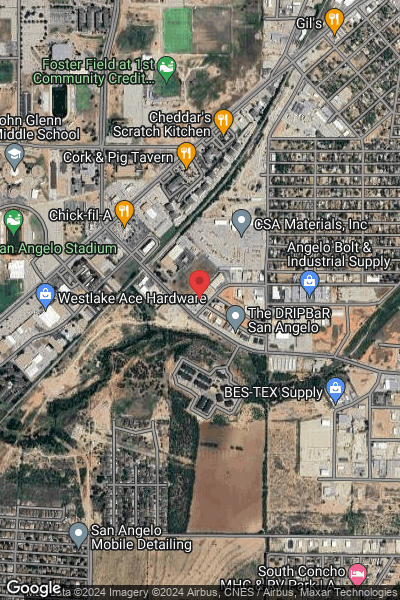FLOORING REPAIR
Maintaining the timeless elegance and durability of hardwood flooring requires diligent care and occasional repairs to address wear and tear. However, daily use and environmental factors can take their toll over time, leading to various damage that detract from the flooring's beauty and functionality.
Assessment of Damage
Before embarking on hardwood floor repair, a comprehensive damage assessment is essential to determine the most effective course of action. Let's explore the inspection process and common types of damage encountered in hardwood flooring.
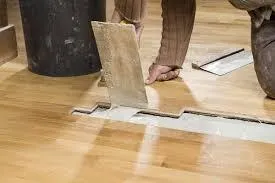
A. Inspection Process
Conducting a Thorough Inspection
The first step in the assessment of hardwood floor damage involves a meticulous inspection of the flooring surface. Our team of experts carefully examines the entire floor, paying close attention to areas prone to wear and tear, such as high-traffic zones and areas susceptible to moisture exposure. We identify any signs of damage using specialized tools and techniques, ranging from minor surface imperfections to more severe structural issues.
Assessing the Extent of Damage
Once the damage has been identified, we assess its extent to determine the appropriate repair techniques. Whether dealing with minor scratches or extensive water damage, understanding the severity of the issue is crucial for developing a tailored repair plan that restores the flooring to its original beauty and functionality.
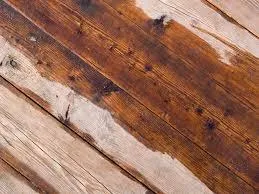
B. Types of Damage
Scratches
Surface scratches are a common form of damage that affects the finish layer of hardwood flooring. These scratches may result from furniture movement, pet claws, or abrasive debris tracked indoors. While superficial scratches may be relatively easy to address, deeper scratches may require more extensive repair techniques to restore the integrity of the finish.
Dents
Deeper indentations in the wood, known as dents, are often caused by heavy furniture or impacts. These dents can mar the appearance of the flooring and compromise its smooth surface. Depending on the severity of the dents, repair options may include sanding, filling, or even replacing damaged boards to achieve a seamless finish.
Water Damage
Water damage significantly threatens hardwood flooring, leading to stains, warping, and discoloration. Signs of water damage may include dark spots, buckling, or a musty odor indicative of mold growth. Addressing water damage promptly is essential to prevent further deterioration and restore the structural integrity of the wood.
Repair Techniques
When it comes to hardwood floor repair, employing the right techniques is essential to achieve optimal results. Let's explore the various repair techniques for addressing surface scratches, deep gouges and dents, and water damage.
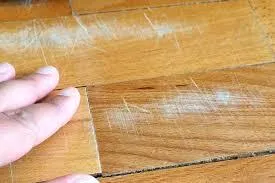
A. Surface Scratch Repair
Sanding
For minor surface scratches, sanding is a highly effective repair technique. Our technicians carefully sand the affected area using fine-grit sandpaper to smooth out imperfections and restore the surface finish. This process removes the damaged layers of wood, revealing a fresh surface that seamlessly blends with the surrounding flooring.
Wood Filler
Deeper scratches or gouges in the wood surface may require the application of wood filler. Our team applies a suitable wood or epoxy filler to the damaged area, filling in the imperfections and achieving a level surface. Once the filler has dried, we sand the area to ensure a smooth and even finish that seamlessly integrates with the surrounding floorboards.
Buffing
Superficial scratches can often be buffed using a rotary buffer and polishing compound. This gentle yet effective technique helps restore the luster of the wood surface, minimizing the appearance of scratches and leaving behind a smooth and glossy finish.

B. Deep Gouge and Dent Repair
Wood Putty
Wood putty or epoxy filler is used to fill in the damaged area for deeper gouges and dents. Our technicians carefully apply the filler, ensuring it blends seamlessly with the surrounding wood grain. Once the filler has dried, we sand the area to achieve a smooth and uniform surface ready for refinishing.
Board Replacement
In cases of severe damage where individual boards are beyond repair, our team may recommend replacing the affected boards. We carefully remove the damaged boards and install new ones, ensuring a seamless transition and preserving the floor's integrity.
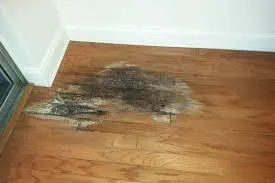
C. Water Damage Restoration
Drying
Addressing water damage begins with thoroughly drying the affected area to prevent further deterioration. Our technicians use specialized equipment such as dehumidifiers and fans to remove excess moisture and promote drying. Once the area is completely dry, we proceed with the repair process.
Sanding and Refinishing
After drying, the damaged area is sanded to remove stains, warping, and other signs of water damage. Once the surface is smooth and free of imperfections, we apply a fresh coat of finish to restore the floor's appearance and protect it from future damage.
Tools and Materials
Ensuring successful hardwood floor repair requires using the right tools and materials. Let's explore the essential items needed for effective repair work.
Essential Tools:
Sandpaper: Various grits of sandpaper are used to smooth out imperfections and prepare the surface for refinishing.
Wood Filler: High-quality wood or epoxy filler for filling in scratches, gouges, and dents.
Putty Knife: A knife for applying wood filler and smoothing it out evenly.
Finishing Products: Stain, sealant, or finish to match the existing floor and restore its appearance.
Recommended Materials:
Wood Putty: A versatile material for filling small cracks, gaps, and imperfections in the wood surface.
Epoxy Filler: A durable filler for repairing deeper gouges and dents in hardwood flooring.
Stain or Finish: Matching stain or finish to blend seamlessly with the existing floor and achieve a uniform appearance.

Safety Precautions
Prioritizing safety is paramount during hardwood floor repair to prevent accidents and ensure the well-being of everyone involved. Let's explore some essential safety precautions.
Importance of Protective Gear:
Goggles: Eye protection to shield against flying debris, dust, and wood particles during sanding and repair work.
Gloves: Heavy-duty gloves to protect hands from sharp tools, chemicals, and abrasive materials.
Proper Ventilation:
Adequate ventilation to minimize exposure to dust, fumes, and volatile chemicals emitted during sanding and finishing processes.
Use respirators or dust masks for additional protection against airborne particles and pollutants.
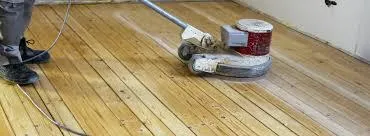
Maintenance Tips
Regular maintenance is key to prolonging the life of your hardwood floors and minimizing the need for future repairs. Let's explore some maintenance tips to keep your floors looking their best.
Preventive Measures:
Use Furniture Pads: Place felt pads or coasters under furniture legs to prevent scratches, dents, and indentations on the hardwood surface.
Area Rugs: Use rugs or mats in high-traffic areas and entryways to protect the hardwood floor from wear and tear.
Periodic Inspections:
Regularly inspect the hardwood floor for signs of damage, such as scratches, dents, or water stains.
Perform routine maintenance, such as cleaning spills promptly, sweeping or vacuuming regularly, and avoiding excessive moisture exposure.
DISCOVER
THE CRAFTSMAN DIFFERENCE
With award-winning third-generation craftsman, Matt Garcia.
FAQS
What is the difference between hardwood and engineered hardwood flooring?
Hardwood flooring is made from solid planks of wood. Engineered hardwood flooring is made with a plywood core and a thin veneer of hardwood on top. Hardwood flooring is more expensive than engineered hardwood flooring, but it is also more durable and can last for many years. Engineered hardwood flooring is less expensive than hardwood flooring, but it is not as durable and may need to be replaced sooner.
What is the best way to clean and maintain my carpet?
The best way to clean and maintain your carpet is to vacuum it regularly and have it professionally cleaned once a year. When vacuuming your carpet, be sure to use a vacuum cleaner with a beater bar to remove dirt and dust from the fibers. When having your carpet professionally cleaned, be sure to choose a reputable company that uses a cleaning method that is appropriate for your type of carpet.
What is the best way to protect my floors from water damage?
The best way to protect your floors from water damage is to avoid spills and leaks. If you do have a spill or leak, be sure to clean it up immediately. You can also protect your floors from water damage by placing mats and rugs in high-traffic areas and by sealing your floors regularly.
TRANSFORM YOUR HOME WITH A CLICK
Why wait for elegance? A free, personalized estimate from Craftsman Hardwood Flooring is just a click away. Join a growing community who have elevated their homes with our exquisite, award-winning flooring designs. Matt Garcia and his team are committed to bringing your vision to life with precision and passion.
Get Your No-Obligation, Free Estimate: Simply fill out our quick form, and we'll provide you with a personalized estimate that aligns with your unique needs and preferences.
See the Difference for Yourself: Browse our gallery of stunning installations and read real testimonials from our satisfied clients.
Let's Create Something Beautiful Together: Start your journey towards a home that truly reflects your style and sophistication. Request your estimate now and step into the world of Craftsman Hardwood Flooring!
Here at Craftsman Hardwood Flooring, we understand that your home is a reflection of your personal style and taste. That's why we offer top-quality hardwood flooring solutions designed to elevate the beauty and functionality of any space.
With our easy-to-use form, you can request a no-obligation, free estimate for your project. This personalized estimate will provide you with an accurate understanding of the costs involved in creating the perfect hardwood floors for your home.
But don't just take our word for it - see the difference for yourself by browsing through our gallery of stunning installations. These real-life examples showcase the exceptional craftsmanship and attention to detail that goes into every project we undertake.
Still not convinced? Take a look at what our satisfied clients have to say
LOCATION
Craftsman Hardwood Floors
958 Arroyo St.
San Angelo, TX 76903
Main Office: (888) 841-8453
QUICK LINKS
COPYRIGHT © 2023
ALL RIGHTS RESERVED. // PRIVACY POLICY // TERMS AND CONDITIONS

